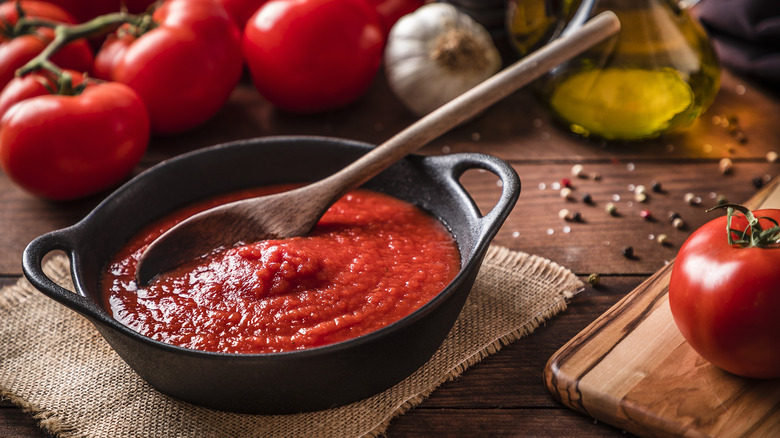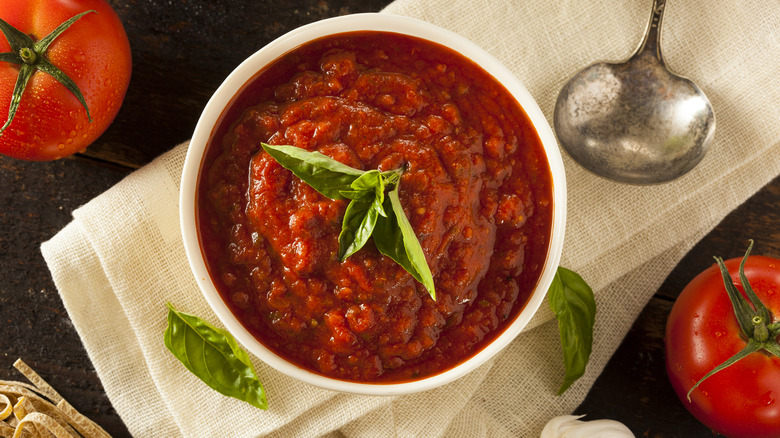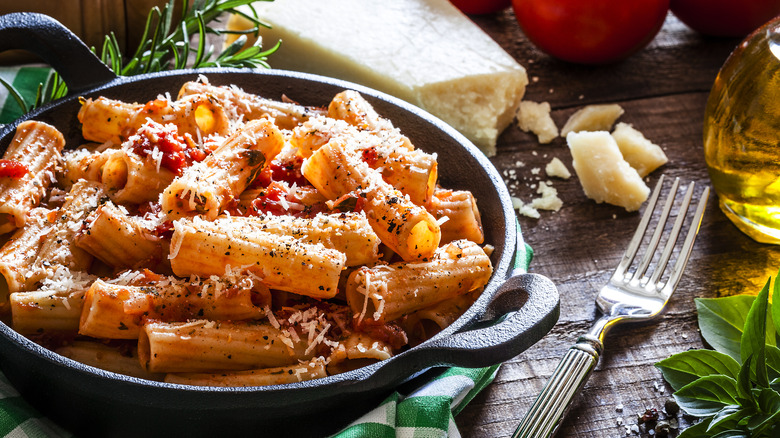The Exact Differences Between Pomodoro And Marinara Sauce
Tomato sauce is one of those ingredients that shows up all over the place; whether you're making pasta or pizza or even just as a dipping sauce for mozzarella sticks, tomato sauce is so ubiquitous it's easy to remember it hasn't actually been around all that long; it wasn't even until the 18th century that tomato sauce became a common component of Italian cuisine. But tomato sauce is tomato sauce, right? One variety is pretty much the same as another.
Wildly, wildly incorrect. Tomato sauce has many iterations, from a traditional slow-cooked pasta sauce to a chunky, not-even-really-technically-a-sauce tomato concasse. And two of the most iconic are terms you're no doubt familiar with — pomodoro and marinara.
But what's the difference between these two sauces? There are several — and the variances can come down to personal preference — but the most universal has to do with texture, where pomodoro is almost always thicker than marinara.
Marinara is a quick-cooked, thin sauce
It helps to understand how marinara is itself different from a traditional tomato sauce. An old-school pasta sauce like your nonna used to make is typically cooked very slowly over the course of hours, simmering on low heat and thickening as its flavors unlock to untold depths. It's designed to be a gradual process.
Marinara, by contrast, is a quick-cooked sauce, simmering for only 30 minutes to an hour. This leads to a much runnier sauce — which isn't necessarily a bad thing. Marinara is exactly what you want out of, say, a tomato dipping sauce for mozzarella sticks or breadsticks. It's also generally marked by being a spice-forward sauce with flavorings such as garlic, oregano, basil, and olive oil. Marinara sauce's name translates to something like "sailor's sauce" in Italian (although we're not entirely sure why it got called that in the first place). It's an easy, universal sauce, and it's not difficult to see why it attained such popularity (particularly in America, where we tend to be obsessed with speed and ease in cooking).
Pomodoro is much more of a traditional pasta sauce
Pomodoro, by contrast, is a little different. It may feature all the same spices as marinara or it may not. What it definitely does feature is finely diced and crushed tomatoes that give it a thick, creamy texture wholly unlike that of marinara, especially since it's meant to be cooked much more slowly than marinara (in other words, like a traditional pasta sauce). Its thickness means it's more spreadable than marinara, making it a common choice as a pizza sauce. It's still thinner than a concasse sauce (which typically consists of large chunks), but it isn't nearly as runny as its cousin marinara. Pomodoro's name, interestingly, means "golden apple" — so called because it was traditionally made with slightly yellow tomatoes in Naples that sort of resembled apples.
Whether you use pomodoro or marinara sauce is largely up to you as a home cook. They're generally interchangeable, and it's largely a matter of personal preference — do you want a sauce that's thinner and faster to make, or creamier and more slow-cooked?


